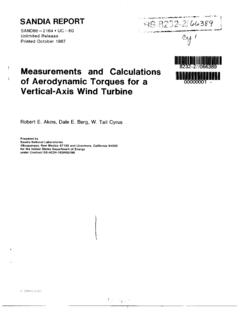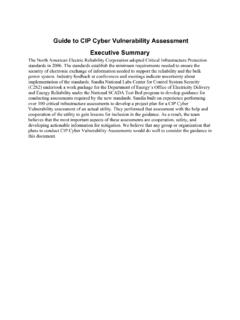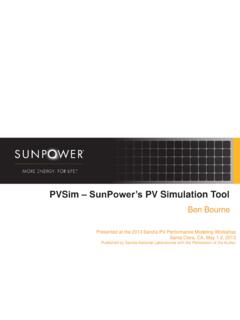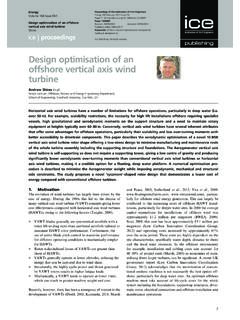Transcription of A Retrospective of VAWT Technology - Sandia …
1 Sandia REPORT SAND2012-0304 Unlimited Release Printed January 2012 A Retrospective of vawt Technology Herbert J. Sutherland, Dale E. Berg, and Thomas D. Ashwill Prepared by Sandia National Laboratories Albuquerque, New Mexico 87185 and Livermore, California 94550 Sandia National Laboratories is a multi-program laboratory managed and operated by Sandia Corporation, a wholly owned subsidiary of Lockheed Martin Corporation, for the Department of Energy's National Nuclear Security Administration under contract DE-AC04-94AL85000. Approved for public release; further dissemination unlimited. -2- Issued by Sandia National Laboratories, operated for the United States Department of Energy by Sandia Corporation. NOTICE: This report was prepared as an account of work sponsored by an agency of the United States Government. Neither the United States Government, nor any agency thereof, nor any of their employees, nor any of their contractors, subcontractors, or their employees, make any warranty, express or implied, or assume any legal liability or responsibility for the accuracy, completeness, or usefulness of any information, apparatus, product, or process disclosed, or represent that its use would not infringe privately owned rights.
2 Reference herein to any specific commercial product, process, or service by trade name, trademark, manufacturer, or otherwise, does not necessarily constitute or imply its endorsement, recommendation, or favoring by the United States Government, any agency thereof, or any of their contractors or subcontractors. The views and opinions expressed herein do not necessarily state or reflect those of the United States Government, any agency thereof, or any of their contractors. Printed in the United States of America. This report has been reproduced directly from the best available copy. Available to DOE and DOE contractors from Department of Energy Office of Scientific and Technical Information Box 62 Oak Ridge, TN 37831 Telephone: (865) 576-8401 Facsimile: (865) 576-5728 E-Mail: Online ordering: Available to the public from Department of Commerce National Technical Information Service 5285 Port Royal Rd.
3 Springfield, VA 22161 Telephone: (800) 553-6847 Facsimile: (703) 605-6900 E-Mail: Online order: #online -3- SAND2012-0304 Unlimited Release Printed January 2012 A Retrospective of vawt Technology Herbert J. Sutherland HJS Consulting Albuquerque, NM Dale E. Berg and Thomas D. Ashwill wind Energy Technologies Department Sandia National Laboratories Box 5800 Albuquerque, New Mexico 87185-1124 Abstract The study of vertical - axis wind Turbine ( vawt ) Technology at Sandia National Laboratories started in the 1970 s and concluded in the 1990 s. These studies concentrated on the Darrieus configurations because of their high inherent efficiency, but other configurations ( , the Savonius turbine) were also examined. The Sandia vawt program culminated with the design of the 34-m Test Bed Darrieus vawt .
4 This turbine was designed and built to test various vawt design concepts and to provide the necessary databases to validate analytical design codes and algorithms. Using the Test Bed as their starting point, FloWind Corp. developed a commercial vawt product line with composite blades and an extended height-to-diameter ratio. The purpose of this paper is to discuss the design process and results of the Sandia 34-m vawt Test Bed program and the FloWind prototype development program with an eye toward future off-shore designs. This paper is our Retrospective of the design, analysis, testing and commercial process. Special emphasis is given to those lessons learned that will aid in the development of an off-shore vawt . -4- -5- Table of Contents page Introduction .. 9 vawt Technology .. 12 The Sandia 34-m Test Bed .. 16 The Rotor .. 17 The Blades .. 17 Aerodynamic Design .. 18 Mechanical Design.
5 18 Modal Response .. 18 Structural Response .. 20 Fatigue Response .. 22 The Tower .. 23 Brakes .. 23 Power Train .. 23 Motor/Generator .. 23 Torque Ripple .. 24 Controller .. 24 Power Production .. 25 Initial Performance .. 26 Performance .. 27 Joints .. 28 Dirty Blades .. 28 Vortex Generator Testing .. 29 Important Results .. 29 The Sandia Point Design .. 32 The Point Design .. 32 Important Results .. 32 The FloWind Commercialization Projects .. 34 The Rotor .. 35 Aerodynamic Design .. 36 Mechanical Design .. 36 The tower .. 37 The Brakes .. 37 Important Results .. 38 Three-Bladed Rotor .. 38 Pultrusion Technology .. 38 Bend-In-Place composite blades .. 39 Deep struts .. 39 40 Aerodynamics .. 40 Structural Dynamics .. 42 Fatigue .. 44 Controls .. 44 -6- Economics .. 45 Cantilever vawt Designs .. 46 H Configuration .. 46 The Musgrove Turbines .. 46 Full Darrieus .. 47 Spindle Configuration .. 47 Space Frame Configuration .. 48 Future Directions .. 49 Aerodynamics .. 49 Airfoils.
6 49 Struts And Joints .. 50 Blade Materials .. 50 Drive Train and Power Components .. 52 Gearbox and Generator .. 52 Torque Ripple .. 52 Brakes .. 52 Configurations .. 54 Three-Bladed Designs .. 54 Cantilever Designs .. 55 H Configuration .. 55 Y Configuration .. 55 Comment .. 56 vawt Designs for Offshore Deployment .. 56 Summary .. 57 Bibliography .. 58 -7- List of Figures page Figure 1. Basic vawt Configurations: (a) Full Darrieus, (b) H , (c) V , (d) , (e) Diamond and (f) Giromill .. 12 Figure 2. Typical Full-Darrieus Turbine Layout .. 13 Figure 3. The Sandia Test Bed vawt .. 16 Figure 4. Blade Section Assemblies .. 17 Figure 5. Blade-to-Blade Joint Detail .. 18 Figure 6. Mode Shapes for the Test Bed .. 19 Figure 7. Rotational Campbell Diagram for the Test Bed .. 20 Figure 8. Flatwise Gravity Stress Distribution in the Test Bed Blades.. 20 Figure 9. Flatwise Centrifugal Stress Distribution in the Test Bed Blades at 28 rpm.. 21 Figure 10. Lower-Root, Flatwise Stresses in the Test Bed.
7 21 Figure 11. Semi-Log Histogram of the Rainflow-Counted Stress for the Test Bed.. 22 Figure 12. Normalized S-N Diagram for 6063-T5 Aluminum.. 23 Figure 13. Variable Speed Control Algorithm .. 25 Figure 14. Power Performance Comparisons for the Test Bed, Impact of Leading Edge Paint Chips.. 26 Figure 15. Leading Edge Condition of the Test Bed .. 26 Figure 16. Rotor Power Performance Comparisons for the Test Bed, Measured vs Predicted.. 27 Figure 17. Measured Rotor Power Coefficient for the Test Bed, Measured vs 27 Figure 18. Fairing over Blade-to-Blade Joint.. 28 Figure 19. Power Production for Clean, Dirty and Faired Blades for the Test Bed.. 28 Figure 20. The Strip Vortex Generators.. 29 Figure 21. The Sandia Point Design, a Commercialized 34-m vawt .. 32 -8- Figure 22. Point Design System Costs (one unit).. 33 Figure 23. Point Design Subsystem Costs (one unit).. 33 Figure 24. The FloWind EHD vawt .. 35 Figure 25. Schematic Diagram of the Musgrove Arrowhead Rotor: (a) Full Extension and (b) Reefed.
8 47 -9- INTRODUCTION The study of vertical - axis wind Turbine ( vawt ) Technology at Sandia National Laboratories started in the 1970 s and concluded in the 1990 s. Initial studies at SNL investigated numerous vawt configurations, including the Savonius and the Darrieus configurations. These studies soon concentrated on the Darrieus configurations because of their high inherent efficiency. Over the years, the designs proposed and tested by Sandia grew in size and power production. The Sandia -designed 17-m (rotor diameter) research machine proved to be very successful and was commercialized by several companies. One of these companies, the FloWind Corp., built and placed over 500 turbines in commercial operation, primarily in the Altamont Pass in California.* The Sandia vawt program culminated with the design of the 34-m Test Bed Darrieus vawt . This turbine was designed and built to test various vawt design concepts and to provide the necessary databases to validate analytical design codes and algorithms.
9 Innovations in the design included airfoils specifically designed to optimize vawt performance and variable-speed operation. Based on the results from the comprehensive test program for this turbine, an extensive suite of design codes was developed and validated. Using the Test Bed as their starting point, the Sandia design team re-engineered the 34-m research vawt into a commercial vawt , the Point Design, a design for deployment in production wind farms. This design was presented to a number of potential developers in 1990. FloWind Corporation, under the auspices of various government/private industry partnership programs with Sandia and NREL, used the Point Design as a starting point for their development of a vawt product line. Their business plan started with the design of a new rotor for their existing fleet of 19-m turbines. With Sandia s and NREL s aid and guidance, FloWind designed an innovative, commercial 3-bladed composite rotor with an extended height-to-diameter ratio.
10 A prototype of this turbine, the 18-EHD turbine, demonstrated that VAWTs were a viable Technology for the commercial production of power for the electric grid. However, financing for a production fleet could not be obtained and FloWind closed its doors. After the closure of FloWind in the mid-1990s, VAWTs were out-of-favor with the wind turbine community. Commercial VAWTs were not pursed to any great extent, and almost all of the US DOE-sponsored vawt -specific wind turbine research was terminated. With the realization that off-shore winds offer a significant resource for power generation from wind turbines located near population centers, the investigation of vawt Technology is again being examined. This examination is predicated on the inherent characteristics of the vawt designs that make them particularly favorable for the production of power in an off-shore environment. The primary vawt characteristics * FloWind Corp.












